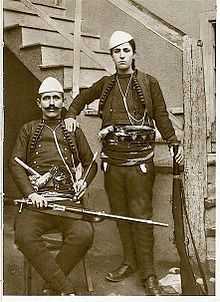Azem Galica
| Azem Galica | |
|---|---|
 | |
| Azem Galica and Shota Galica | |
| Personal details | |
| Born | 1889 Galica, Drenica, Ottoman Empire |
| Died | July 15th, 1924 (aged 35) Junik, Kingdom of Serbs, Croats and Slovenes |
| Religion | sunni islam |
| Military service | |
| Allegiance | Provisional Government of Albania, Committee for the National Defence of Kosovo |
Azem Bejta (1889–1924), commonly known as Azem Galica, was an Albanian nationalist and rebel who fought for the unification of Kosovo with Albania.
Biography
Early life
Azem Bejta was born in the village of Galica (medieval Kalica) in the Drenica region of the Kosovo Vilayet, Ottoman Empire. He was the son of Bejta Galica, a patriot who died fighting against the Ottoman Empire and for Albania's separation from the Serbian state. Azem followed his father, and first fought against the Kingdom of Serbia in 1912.
Resistance against Serbia
Azem Galica was one of the leaders of armed resistance to Serbian rule in Kosovo in the years 1912-1914. With his Kacak fighters, he resisted Serbian forces that invaded Kosovo during the Balkan Wars and early in World War I.[1] In the winter of 1915–16, during World War I, Kosovo saw the Serbian army retreat when Kosovo was occupied by Bulgaria and Austria-Hungary.
Bulgaria and Austria-Hungary
In 1915, after the Austro-Hungarian occupation of Kosovo following the rout of the Serbians, Azem Galica began an armed resistance against the new invaders.[2] However, after persuasion by Luigj Gurakuqi, Prenk Bib Doda and Fejzi Alizoti, as well as the opening of 300 Albanian schools, the right to fly the Albanian flag, and assurances that the Austrians would respect the customs of the country, the Albanian language, and both the Christian and Muslim religions, Azem Galica accepted the Austrian occupation.[2]
In 1918, the Serbian Army pushed the Central Powers out of Kosovo. After World War I ended, Kosovo found itself in the Kingdom of Serbs, Croats and Slovenians (later known as the Kingdom of Yugoslavia) on 1 December 1918. Galica again became an outlaw, fighting again the soldiers and police of the King.[1]
Resistance against Yugoslavia
Disaffected Kosovar Albanians, who had rallied around Hasan Pristina, formed a 'Committee for the National Defence of Kosovo' in Shkoder in 1918, their main demand being the unification of Kosovo with Albania.[3] The best known of the Kachak leaders were Bajram Curri, Hasan Pristina and Azem Galica. A general revolt started, known as the Kachak (outlaw) movement, led by Azem Galica, against the incorporation of Kosovo into Yugoslavia.[3] Fighting blew up in Drenica, Azem Galica's home territory.[4] It was estimated that there were 10,000 active rebels at this time.[4]
His wife Qerime Radisheva, known as Shota Galica, fought alongside Azem Galica. They succeeded in creating a "free zone" in the western part of Kosovo around Junik, called "Arberia e Vogel" (little Arberia). The Yugoslav kingdom, however, had no intention of letting this zone survive, and with superior fire power and troop numbers they moved into Junik. They succeeded in wounding Azem who later died from his wounds. His last wish was for his body not to be found by the Serbs, and thus he was buried in a deep cave. He died on July 15, 1924.[1]
Aftermath
The death of Galica dealt a mortal blow to the armed resistance against Yugoslav military oppression in Kosovo, which he had led for the past eight years.[2] The Yugoslavs intensified their repression of the Albanian national movement in Kosovo.[2]
Apart from some small groups which were never subdued, the end of the major Kacak resistance came when Yugoslav government helped Ahmed Zogu to return to power in Tirana in December 1924, in exchange for his suppressing the Committee for the National Defence of Kosovo.[4]
Legacy
As national heroes, Azem and Shota Galica epitomized the Albanian Kosovar resistance.[5] The Albanians gave these fighters for a national cause a rightful place in history, celebrating them as martyrs for the nation. Their sacrifice was seen as integral to the national effort to free Kosovo from Serbian rule.[5] In the long term, the killing of the Galicas and of many others stimulated, and set an example of, Albanian resistance against repression and inequality in Kosovo.[5]
See also
- Kachak
References
- ↑ 1.0 1.1 1.2 Elsie, Robert (2004). Historical Dictionary of Kosova. The Scarecrow Press. p. 63. ISBN 0-8108-5309-4.
- ↑ 2.0 2.1 2.2 2.3 Owen Pearson. Albania in the Twentieth Century, A History: Volume I: Albania and King Zog. Retrieved 8 August 2012.
- ↑ 3.0 3.1 Paulin Kola. The Search for Greater Albania. Retrieved 8 August 2012.
- ↑ 4.0 4.1 4.2 Tim Judah. Kosovo: War and Revenge; Second Edition. Retrieved 8 August 2012.
- ↑ 5.0 5.1 5.2 Denisa Kostovicova. Kosovo The Politics of Identity and Space. Retrieved 8 August 2012.